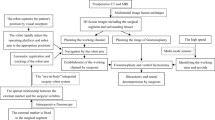Abstract
Purpose
Preoperative planning is of great importance for transforaminal endoscopic techniques applied in percutaneous endoscopic lumbar discectomy. In this study, a modular preoperative planning software for transforaminal endoscopic surgery was developed and demonstrated.
Methods
The path searching method is based on collision detection, and the oriented bounding box was constructed for the anatomical models. Then, image reformatting algorithms were developed for multiplanar reconstruction which provides detailed anatomical information surrounding the virtual planned path. Finally, multithread technique was implemented to realize the steady-state condition of the software.
Results
A preoperative planning software for transforaminal endoscopic surgery (TE-Guider) was developed; seven cases of patients with symptomatic lumbar disc herniations were planned preoperatively using TE-Guider. The distances to the midlines and the direction of the optimal paths were exported, and each result was in line with the empirical value.
Conclusions
TE-Guider provides an efficient and cost-effective way to search the ideal path and entry point for the puncture. However, more clinical cases will be conducted to demonstrate its feasibility and reliability.







Similar content being viewed by others
References
Ahn Y, Lee SH, Park WM, Lee HY, Shin SW, Kang HY (2004) Percutaneous endoscopic lumbar discectomy for recurrent disc herniation: surgical technique, outcome and prognostic factors of 43consecutive cases. Spine (Phila Pa 1976) 29:326–332
Kambin P, Zhou L (1997) Arthroscopic discectomy of the lumbar spine. Clin Orthop Relat Res 337:49–57
Nellensteijn J, Ostelo R, Bartels R, Peul W, van Royen B, van Tulder M (2010) Transforaminal endoscopic surgery for symptomatic lumbar disc herniations: a systematic review of the literature. Eur Spine J 19:181–204
Hoogland T, van den Brekel-Dijkstra K, Schubert M, Miklitz B (2008) Endoscopic transforaminal discectomy for recurrent lumbar disc herniation: a prospective, cohort evaluation of 262 consecutive cases. Spine (Phila Pa 1976) 33:973–978
Tjardes T, Shafizadeh S, Rixen D, Paffrath T, Bouillon B, Steinhausen ES, Baethis H (2010) Image-guided spine surgery: state of the art and future directions. Eur Spine J 19:25–45
Nowitzke A, Wood M, Cooney K (2008) Improving accuracy and reducing errors in spinal surgery—a new technique for thoracolumbar-level localization using computer-assisted image guidance. Spine J 8:597–604
Gebhard FT, Kraus MD, Schneider E, Liener UC, Kinzl L, Arand M (2006) Does computer-assisted spine surgery reduce intraoperative radiation doses? SPINE 31(17):2024–2027
Ruetten S, Komp M, Merk H, Godalias S (2007) Use of newly developed instruments and endoscopes: full-endoscopic resection of lumbar disc herniations via the interlaminar and lateral transforaminal approach. J Neurosurg Spine 6:521–530
Kafadar A, Kahraman S, Akbörü M (2006) Percutaneous endoscopic transforaminal lumbar discectomy: a critical appraisal. Minim Invasive Neursurg 49:74–79
Hsu HT, Chang SJ, Yang SS, Chai CL (2013) Learning curve of full-endoscopic lumbar discectomy. Eur Spine J 22:727–733
Wang H, Huang B, Li C, Zhang Z, Wang J, Zheng W, Zhou Y (2013) Learning curve for percutaneous endoscopic lumbar discectomy depending on the surgeon’s training level of minimally invasive spine surgery. Clin Neurol Neurosurg 115:1987–1991
Lee DY, Lee SH (2008) Learning curve for percutaneous endoscopic lumbar discectomy. Neurol Med Chir (Tokyo) 48:383–389
Ruetten S, Komp M, Godolias G (2005) An extreme lateral access for the surgery of lumbar disc herniations inside the spinal canal using the full-endoscopic uniportal transforaminal approachtechnique and prospective results of 463 patients. Spine (Phila Pa 1976) 30:2570–2578
Gu X, He S, Zhang H (2013) Morphometric analysis of the YESS and TESSYS techniques of percutaneous transforaminal endoscopic lumbar discectomy. Clin Anat 26:728–734
Lorensen WE, Cline HE (1987) Marching cubes: a high resolution 3D surface construction algorithm. ACM Comput Graph 21:38–44
Kambin P, Gellman H (1983) Percutaneous lateral discectomy of the lumbar spine. A preliminary report. Clin Orthop 174:127–132
Gottschalk S, Lin M, Manocha D (1996) OBB-Tree: a hierarchical structure for rapid interference detection, ACM SIGGRAPH. In: Rushmeier H (ed) SIGGRAPH 96 conference proceedings. Addison Wesley, Reading, pp 171–180
Albert TJ, Balderston RA, Heller JG, Herkowitz HN, Garfin SR, Tomany K, An HS, Simeone FA (1993) Upper lumbar disc herniations. J Spinal Disord 6(4):351–359
Ido K, Shimizu K, Tada H, Matsuda Y, Shikata J, Nakamura T (1998) Considerations for surgical treatment of patients with upper lumbar disc herniations. J Spinal Disord 11(1):75–79
McCulloch JA (1999) Alternative forms of disc excision. In: Rothman R, Simeone F (eds) The spine, 4th edn. Saunders, Philadelphia, pp 691–714
Sanderson SP, Houten J, Errico T, Forshaw D, Bauman J, Cooper PR (2004) The unique characteristics of “upper” lumbar disc herniations. Neurosurgery 55(2):385–389 discussion 389
Ahn Y, Lee SH, Lee JH, Kim JU, Liu WC (2009) Transforaminal percutaneous endoscopic lumbar discectomy for upper lumbar disc herniation: clinical outcome, prognostic factors, and technical consideration. Acta Neurochir 151:199–206
Gibson JN, Cowie TG, Iprenburg M (2012) Transforaminal endoscopic spinal surgery: the future ‘gold standard’ for discectomy?—a review. Surgeon 10:290–296
Yeung AT, Yeung CA (2003) Advances in endoscopic disc and spine surgery: foraminal approach. Surg Technol Int 11:255–263
Yeung AT (2000) The evolution of percutaneous spinal endoscopy and discectomy: state of the art. Mt Sinai J Med 67:327–332
Yeung AT, Tsou PM (2002) Posterolateral endoscopic excision for lumbar disc herniation: surgical technique, outcome, and complications in 307 consecutive cases. Spine 27:722–731
Acknowledgments
This work was supported by National Natural Science Foundation of China (Grant Nos.: 81171429 and 81511130089), Shanghai Pujiang Talent Program (Grant No.: 13PJD018), Foundation of Science and Technology Commission of Shanghai Municipality (Grant No.: 14441901002) and SJTU—KU Leuven Fund.
Author information
Authors and Affiliations
Corresponding author
Ethics declarations
Conflict of interest
The authors declare that they have no conflicts of interest in relation to this article and they respect protection of human and animal rights.
Additional information
Xiaojun Chen and Jun Cheng have contributed equally to this work.
Part of this work first appeared on the 29th International Congress on Computer Assisted Radiology and Surgery (CARS2015), Barcelona, Spain.
Rights and permissions
About this article
Cite this article
Chen, X., Cheng, J., Gu, X. et al. Development of preoperative planning software for transforaminal endoscopic surgery and the guidance for clinical applications. Int J CARS 11, 613–620 (2016). https://doi.org/10.1007/s11548-015-1282-2
Received:
Accepted:
Published:
Issue Date:
DOI: https://doi.org/10.1007/s11548-015-1282-2




